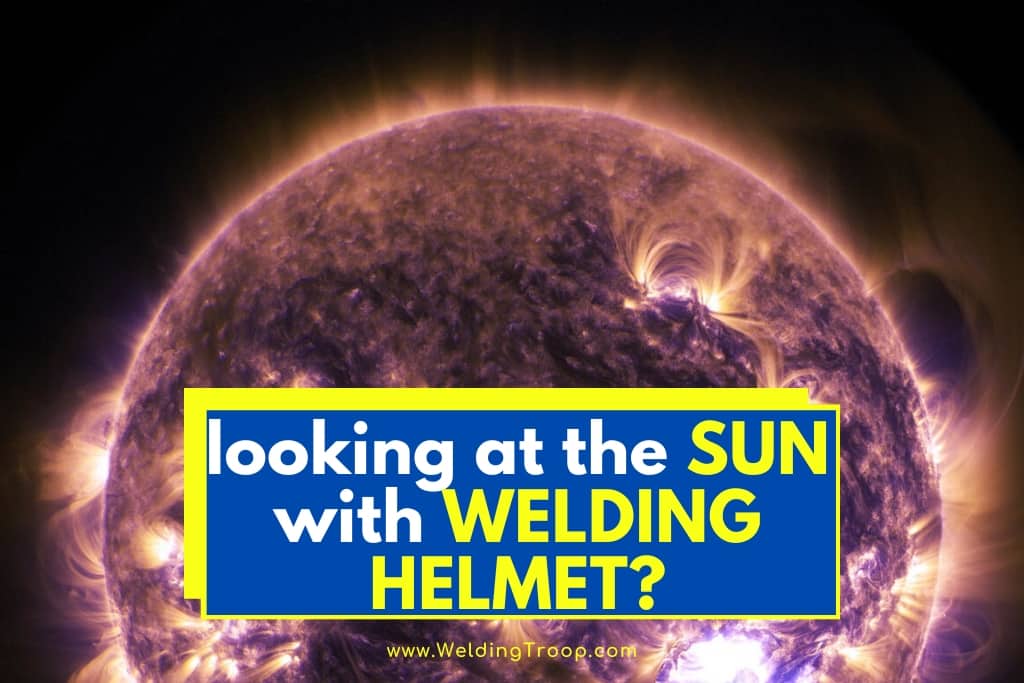Solar eclipses occur somewhere on Earth every 18 months, but only in the same area every 100 years or so. Glasses specially made for solar eclipses are hard to find sometimes, so what if you don’t have them?
What if your line of work puts your eyes in the direct path of the sun, and you don’t have eye protection?
Can you look at an eclipse or the sun with a welding mask? Yes, you can do both with a welding mask if the shade of your welding mask is 12 or higher. Anything less than 12 shade will not adequately protect your eyes, and most welding masks you can easily find in stores are not 12 shade.
The damage that can be done to your eyes when looking directly at the sun, or an eclipse, is irreversible. You can go blind if too much damage is done, or you may end up with severe vision problems for the rest of your life.
You need to protect your eyes against solar events at all costs. Read on to learn how to use welding masks to do so.
Table of Contents
How Do Welding Masks Protect Your Eyes?
When you wear a welding mask, it covers your entire face, and it has a window on the front so you can see what you are working on. These windows are tinted based upon the amount of UV or infrared light you will need to filter out.
The UV or infrared lights come from the reaction of heat against metal, which differs depending on what kind of metal you are welding.
Most people buy helmets that are the darkest shade so they can use it with all types of projects and metals.
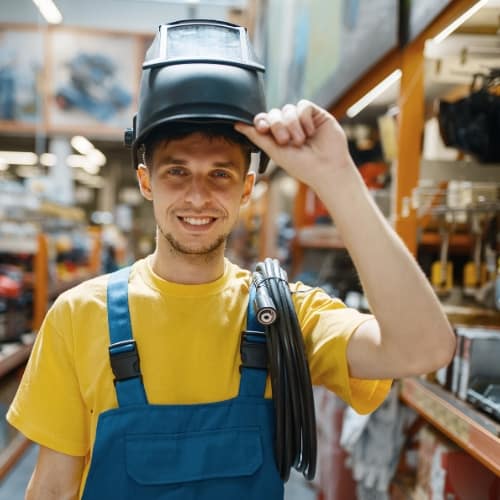
Welding masks are fantastic to use because of their ability to provide full coverage. You can wear them over your regular glasses, and they usually stay on better than typical sunglasses.
If there are no cracks or scratches, and the shade is dark enough, your eyes will be fully protected from the UV lights.
There are two types of welding masks you can buy, and each one can be bought at different shade levels, depending on what you need.
Related reading: How To Choose A Welding Helmet: What To Consider
Welding masks are built with specific lenses that are darkened to filter out individual UV lights, so they don’t reach your eyes in harmful amounts. While it’s not possible to filter out all of the UV light, they filter out enough, so your eyes are not damaged or affected by the intense UV lights.
The lowest (and worst) shade to use is a 2. It is only acceptable for torch soldering and will not protect your eyes from anything other than some kinds of work and indirect sunlight.
Related reading: What Do Welding Shade Numbers Mean? What Shade Is Safe?
A 2 shade is only suitable for one job and can cause serious harm if used for anything else.
However, if you buy a shade 14, which is the highest, your eyes will be protected from almost all UV rays no matter what you are looking at.
Note: While you can use a welding helmet to directly view the sun, if you do not have anything else, NASA recommends using a special sun gazing solar filter. This filter is specifically designed to filter out the maximum amount of UV lights for the highest amount of protection for your eyes.
Auto-Darkening Welding Masks
While these are very useful because of the range of UV or infrared light different metals emit, not all auto-darkening welding helmets darken to level 12.
These helmets usually have limits to how much they will darken and will be labeled with their strength.
These helmets also have sensitivity and delay settings that allow for quicker response to darkening.
Related reading: Are Auto-Darkening Welding Helmets Safe? What You Need To Know
The quick response to the darkness setting allows for your eyes to have less exposure to UV lights, but it can also cause a darker view when you don’t necessarily need it.
Making sure you know how to use and set the settings correctly will help in the mask’s ability to protect your eyes.
Fixed Shaded Welding Masks
These masks are shaded at set darkness. Usually, each helmet has numbers that correspond with the amount of UV or infrared light it filters out.
These masks are generally cheaper than auto-darkening, but you would need different ones if you had metals that required different shades.
Some highly-rated welding masks that you can consider are:
- TOOLIOM 3.97×3.7 inch Large Viewing Welding Helmet True Color Welding Mask – Different styles in ranging prices for budget-friendly decisions
- YESWELDER Large Viewing True Color Solar Powered Auto Darkening
- Antra AH6-260-0000 Auto Darkening Welding Helmet – A very basic helmet with coverage to shade 13, very budget-friendly.
How Do Welding Masks Protect Your Eyes?
In the most basic of terms, your eyes can be sunburned, just like your skin. The light that the sun gives off is called ultraviolet rays, and these can damage your eyes.
The three types of ultraviolet rays that are damaging are:
- UVC (Ultraviolet C) – the Ozone blocks nearly all of these damaging rays
- UVB (Ultraviolet B) – weaker than UVC, but these rays cause lots of problems for skin and eyes.
- UVA (Ultraviolet A) – weakest of the rays; however, these can seriously damage your eyes and cause most of the problems.
Allowing your eyes to be exposed to unprotected sunlight can cause a long list of issues:
- Irritability – grittiness, itching, burning, watering.
- Sensitivity – trouble looking at bright screens or being outside at all without eye protection
- Cataracts – a breakdown in the proteins of your eye lens, causing vision issues
- Macular Degeneration – the breakdown of the central portion of the retina, usually causing vision loss
- Pinguecula – raised yellow bumps on the outer lens of the eye; usually reversible but causes irritation
Related reading: 7 Easy Steps to Prevent Welding-Related Injuries
Facts and Tips About Eye Damage
Eye damage is not an uncommon thing. However, there is a large amount of misinformation about how and why eye damage occurs. Here are some simple facts that can help you understand the importance of protecting your eyes, even in the small moments in the sun:
- Permanent eye damage can occur within 100 seconds – this can shorten depending on the intensity of the sun that particular day.
- Drugs that dilate your pupil can speed up the damaging effects of the UV light due to the amount your eye will absorb.
- Most people don’t see the damaging effects of the sunlight until they are in their 50s or above, usually as a result of small moments throughout their lives.
- Short-term damage can occur when looking directly at the sun too long and usually causes blindness almost immediately. However, this is so painful that it rarely happens.
- Long term damage is almost impossible to prevent entirely, but you can protect yourself by wearing glasses that block both UVA and UVB
Related reading: Does Welding Hurt Your Eyes? How Can You Protect Your Eyes
How Solar Eclipse Glasses Work
First, let’s take a closer look at how solar eclipse glasses work, and why they work in protecting your eyes against the sun where other options do not.
For our purposes here, sunlight is composed of three different elements we care about: the visible light we can see as part of the electromagnetic spectrum, UVB rays, and UVA rays.
The first is what is visible to your eye, and what may be shielded by traditional sunglasses and welding helmets.
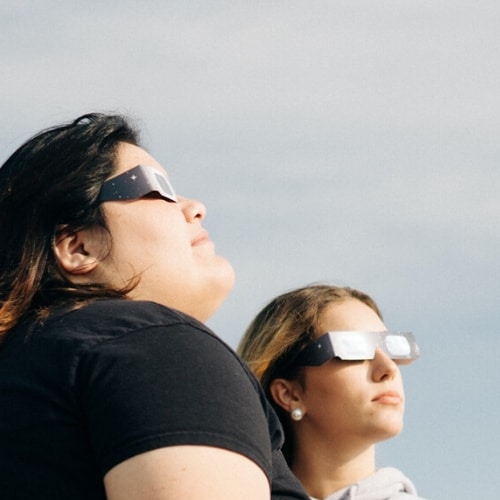
However, it is the other two that are far more concerning.
The problem with sunglasses is that they do not block nearly enough of the UVA and UVB rays to be effective in protecting your eyes against them.
Sunglasses – like most welding helmet visors – are typically only made of glass or glass blends with polycarbonate or plastic materials.
These only block out about 10 to 20% of UVA and UVB rays. What’s more, while it blocks some visible light, it does not block it all.
All of this makes sunglasses far too weak to be used to look at the sun in a safe way for any extended period of time, let alone do so during a solar eclipse.
By contrast, the type of special solar eclipse glasses mentioned above may look similar to regular glasses and welding visors, but are in fact around 100,000 stronger and darker.
They are also made from different materials, namely a type of black polymer with resin and carbon particles. This allows these sunglasses to block out all UV rays along with most visible light, which is why they are safe for looking at the sun while regular sunglasses are not.
The Consequences of Staring Directly at the Sun
Icarus flew too close to the sun, and faced the consequences. You want to avoid the same fate, and so ideally you shouldn’t be looking at the sun to begin with.
What will happen if you fail to heed that warning?
UVB rays and UVA rays can cause extensive eye damage, resulting in blurred vision, pain, and even permanent blindness.
How does this happen?
Your cornea is part of the outer surface of your eye. That said, it is still quite delicate, and hardly the sort of thing you would want to expose to the intensity of UV light.
When you expose your cornea to UV rays, its cells can start to burn and your eyes begin to blister and crack. The name for that horrifying condition is photokeratitis, and it’s something that should be avoided at all costs.
That said, if you stare straight up at the sun – welding helmet or otherwise – and feel fine, don’t think you’ve cheated the odds.
The effects of photokeratitis can take a few hours before they start to show up, and once they do, they emerge with a vengeance. Your eyes can start to feel gritty, inflamed, raw, and incredibly uncomfortable.
Related Article: How Long Does Welders Flash Burn Last? Symptoms and Treatments
If you are “lucky,” and rest your eyes immediately and completely, this sensation might pass in a few hours. However, if you aren’t so lucky, or stare at the sun for too long, you may permanently damage your eyes.
Exposing your retinas to too much light can overstimulate them, which in turn can cause them to release chemicals which, when released all at once in large concentrations, can damage the tissues in your eyes.
This is one of the major causes of eye damage resulting from staring at the sun. While you may think that you might be able to block this out with sunglasses or most welding mask settings, as demonstrated above, that simply is not the case.
Only solar eclipse glasses that are specially designed for this purpose and feature materials that can offer the extreme shaded darkness necessary can fully protect your retinas from the sun’s UV rays and the resultant retinal, macular, and corneal damage.
The greater the amount of tissue damage to your eyes, the more unlikely recovery becomes. Twelve months is about the upper limit for most cases of recovery. If your eyes have not recovered by then, it is very unlikely that they ever will.

In short, UVB rays can destroy its outer cells. UVA rays can damage your eyes’ lenses, which in turn can lead to your retina and macular damage, which can lead to macular degeneration and temporary or permanent blindness.
What About viewing Solar Eclipse with Welding Helmets?
With all that information in tow, let’s tackle the issue of welding helmets. After all, while we discounted sunglasses above, and touched on welding helmets as well, the latter are a bit different and better suited to the task.
For one thing, welding helmets tend to feature thicker and more light-resistant glass than sunglasses. Far more importantly, however, they can get a lot darker than your average pair of shades.
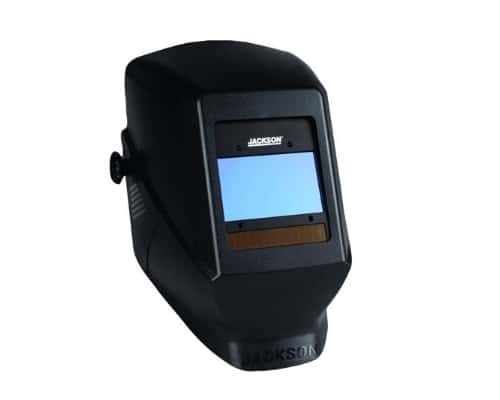
That’s why, under very limited circumstances, you may be able to look at the sun with a welding helmet with a greater degree of safety than you can with sunglasses.
That said, whether this is “safe” is another matter. It is important to present this information with the caveat that looking at the sun, especially during a solar eclipse, with anything other than approved solar eclipse glasses is not condoned by NASA or similar bodies informed on the subject.
You do so at your own risk, and it may not be a risk you are willing to take.
That said, from a purely academic perspective, welding helmets with a minimum shade darkness factor of 12 can potentially offer enough protection to at least approach what you would need to protect your eyes against UV light.
Even this may be a bit light. A shade factor of 13 may be even better.
That said, a great deal of precision is needed to make this work.
For one thing, you need to be absolutely sure that you are using a welding helmet with visors at the correct degree of darkness. If you do not know the shade factor, do not use it.
The same goes for the helmet overall. You should never use a welding helmet unless you have absolute faith in its integrity and capabilities, and that’s especially true for something as extremely risky as looking at the sun.
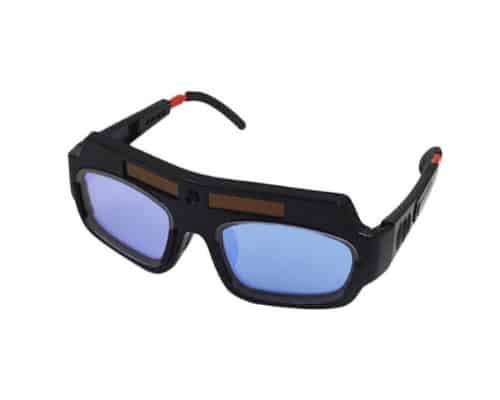
You should also take care to follow the precautions given by groups such as NASA and the National Safety Council.
Finally, you should follow the same safety protocols as those wearing the actual NASA-approved solar eclipse sunglasses, including:
- Always inspect the solar filter before using it
- Never use any lens which is scratched, torn, punctured, or in any way damaged
- If you usually wear glasses, wear them underneath your welding helmet/solar eclipse sunglasses
- Stand still
- Shade your eyes
- Do not under any circumstances remove the welding helmet/solar eclipse sunglasses
- Do not view the eclipse or stare at the sun through a telescope, as the magnification and concentration of light can lead to eye damage
So, can you look at the sun with a welding helmet?
Regardless of whether you can, you probably shouldn’t do so. Solar eclipse glasses are highly specialized with protective eye features greater than even the transitional tinting of welding helmets.
With the stakes as high as temporary blindness or worse, this isn’t something to play around with.
Still, what about the academic answer to the question? Even if you shouldn’t do it, can you?
The answer is yes, with a couple huge reservations. First, you need to make sure that the helmet you are using is snugly in place. A single slip is all it takes to expose your eyes to dangerous rays that may irreparably damage them.
Only welding helmets with a darkness factor of 12 or higher can approach the degree of safety you would need to stare at the sun.
While in practice, it is probably safest to listen to NASA and only use solar eclipse glasses, in theory at least, it is technically possible to look at the sun while wearing welding helmets with the strongest darkness settings.
In Conclusion
Overall, you can use a welding mask to look at the sun and an eclipse. You need to know the exact shade your helmet is to make sure it will protect you, and you need to make sure it is not taken off when looking at the sun.
Welding masks provide excellent coverage, which reduces the risk of accidentally looking at UV lights through the spaces above or below regular sunglasses.
Protecting your eyes is far more critical than ever getting a “better look” at the sun, so don’t fall into that trap. Your eyes are too essential of a tool to damage due to a lack of protection.
Sources:
https://eclipse2017.nasa.gov/safety
Recommended Reading
Does Welding Hurt Your Eyes? How Can You Protect Your Eyes
How Long Does Welders Flash Burn Last? Symptoms and Treatments
Personal Protective Equipment for Welders – PPE | List, and Requirements
A solar eclipse can cook your eyes: How to watch safely >> Video
Here are some of my favorite tools & equipment´s
Thank you for reading this article. I hope it helps you find the most recent and accurate information for your welding project. Here are some tools that I use daily and hope you´ll also find helpful.
There are affiliate links, so if you do decide to use any of them, I´ll earn a small commission. But in all honesty, these are the exact tools that I use and recommend to everyone, even my own family. (NO CRAP)
To see all my of most up-to-date recommendations, check out this resource that I made for you!

